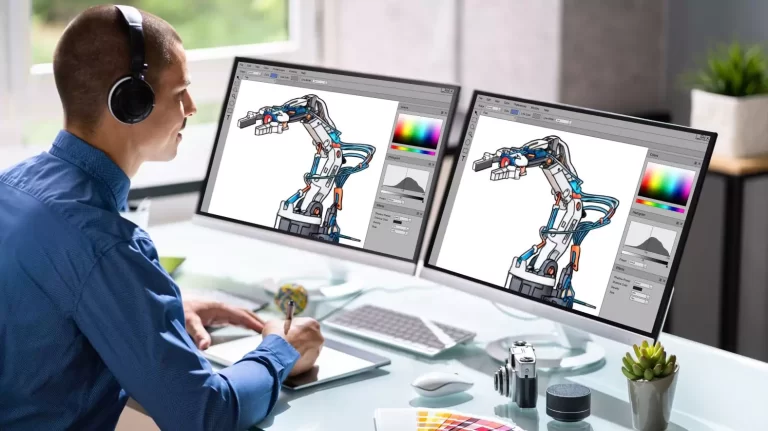Graphic Design Or Logo Design
Have you ever wondered how the captivating visuals of your favorite brands come to life? Graphic designers or logo makers are the creative minds behind these visually stunning creations. They create distinctive and captivating graphic design that makes an impression on audiences by utilizing their artistic talent.
If you are a creative graphic designer and want to create a graphic design or logo design, you don’t need to worry. I have brought a step-by-step guide to create a unique logo design. Now, you can design a sleek logo that conveys a brand’s story in a single glance or produce eye-catching graphics for various marketing materials.

How to Design a Logo? / Guide to a Graphic Design or Logo Design
Here are steps to follow while making a graphic design or Logo Design.
1. Start with Your Story
Your logo should tell a story that connects with your audience because it is the visual embodiment of your brand’s identity. Investigate the history and purpose of your brand thoroughly to start. Recognize the “why” for the existence of your business. What drives your business besides the desire to make money? Is it a dedication to sustainability, a love of excellence, or a desire to improve people’s lives?
Consider how the visual components of your logo best represent this story. Think about the feelings, ideals, and encounters you want your audience to have when they think of your brand. People don’t simply think of a drink when they see the Coca-Cola logo; for instance, they also think of happiness, nostalgia, and community. Your brand’s essence should be captured in your logo.
2. Brainstorm Words That Describe Your Brand
Conduct a brainstorming session to find the words and phrases that best describe what your business does. It ensures that your logo appropriately captures the soul of your company. This exercise not only aids in the clarification of your brand’s identity but also offers priceless design ideas for your logo.
Use resources like Thesaurus.com to explore synonyms and related terms for your core keywords. Take the example of a clothing brand. While “clothing” may be the primary keyword, you’ll discover descriptive synonyms like “apparel,” “fashion,” “attire,” and “garments.” Each of these words can offer a unique perspective on your brand’s identity.
3. Sketch Ideas Based on These Words
Sketching is a creative process that allows you to visualize your brand’s identity through various design elements. Armed with your keywords and the core story of your brand, pick up a pencil and paper and start sketching. During this phase, remember to keep the shapes and symbols in your sketches simple and distinctive.
Simplicity ensures that your logo is easily recognizable. Avoid using generic symbols or clip art, as these can dilute your brand’s uniqueness. Focus on being creative and genuine in your artwork to create a logo representing your brand.

4. Test Your Top Sketches with Your Buyer Persona
Once you’ve sketched a variety of logo concepts, it’s time to seek feedback from others. Choose the top three concepts that resonate with you and others who understand your brand vision. Share these drafts with friends, family members, and trusted colleagues.
For the most valuable insights, consider involving individuals who closely match your ideal customer profile. Their feedback can provide a realistic perspective on how potential customers might perceive your brand based on your logo. Be open to constructive criticism, as it will help you refine your designs and make them more appealing to your target audience.
5. Refine Your Chosen Sketch
After receiving feedback and selecting a preferred sketch, it’s time to refine and polish your chosen concept. Revisit the list of keywords and phrases you generated earlier. Evaluate whether your selected sketch effectively captures the essence of your brand as described by these terms.
During the refinement process, you can incorporate elements from other sketches you liked but didn’t initially choose for development. This step allows you to enrich your chosen concept, making it even more representative of your brand’s unique identity.
6. Develop Your Logo’s Layout on a Free Design Platform
The transition from paper sketches to digital design by using free design platforms like Appy Pie’s Logo Maker or Logo Crisp. These tools enable you to recreate your sketch in a digital format, making it suitable for various applications.
Pay close attention to the layout of your logo. Ensure that all text and shapes are correctly spaced and aligned. This step is crucial because your logo will be used in diverse contexts, and it must appear consistent and professional in all of them.
7. Pick Versatile Color Options
Your logo’s color scheme should be visually appealing and adaptable to different backgrounds. Consider the example of Coca-Cola, whose red and white logo looks striking on various-colored cans. To achieve this versatility, create color variations of your logo that work effectively on both dark and light backgrounds.
These color variations may involve adjusting the color of your font or, in some cases, modifying the entire color palette of your logo. By preparing these variations, you ensure that your logo remains impactful and legible regardless of where it’s used or displayed.
8. Choose a Font
If your chosen sketch incorporates text, selecting the right font is essential. The font you choose should complement the overall design of your logo and align with your brand’s personality and values.
Avoid generic fonts commonly found in standard word processors, as they can make your brand less memorable and fail to convey uniqueness. Instead, opt for distinctive typefaces that reflect your brand’s identity, whether it’s classic and elegant (serif) or modern and clean.
9. Ensure Scalability
Your logo will appear on various platforms and materials, so it must be scalable. This means it should look equally good when resized for different purposes, from large billboards to small promotional items like pens or badges.
Test the logo at different sizes to ensure it remains clear, recognizable, and visually appealing. A well-designed logo will maintain its impact and legibility, regardless of the scale at which it’s presented.
By following these expanded steps, you can create a logo that effectively communicates your brand’s identity and resonates with your target audience.
FAQs
Why is a logo important for a brand?
Because it represents a brand’s identity visually, a logo is significant. It helps establish brand recognition, fosters trust, and conveys to the audience the essence of the brand. A distinctive logo may make a brand recognizable and leave a lasting impression.
How can I guarantee that my logo is original?
Make sure your logo is original by doing extensive research to find other company logos in your sector. Focus on producing a design that is different and captures the uniqueness of your business rather than employing clichés or common symbols. To prevent copying, you can also think about trademarking your logo.
What constitutes a successful logo?
The characteristics of a successful logo include frequent simplicity, adaptability, memorability, and relation to the identity of the brand. Additionally, it should be scalable and effective in both color and monochrome.
Summary
The careful process of creating a graphic design or logo design goes beyond simple aesthetics. It involves creating a visual story that captures the spirit of a business and connects with its target market.
The path to an engaging logo begins with a thorough grasp of the brand’s story and mission. Following these steps offers a thorough tutorial for anyone looking to develop a graphic design that successfully conveys their brand’s identity and makes an impact.
